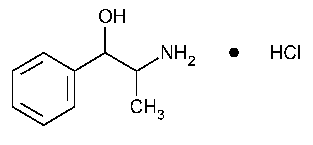Phenylpropanolamine Hydrochloride
»Phenylpropanolamine Hydrochloride contains not less than 98.0percent and not more than 101.0percent of C9H13NO·HCl,calculated on the dried basis.
Packaging and storage—
Preserve in tight,light-resistant containers.
USP Reference standards á11ñ—
USP Cathinone Hydrochloride RS.USP Dextroamphetamine Sulfate RS.USP Phenylpropanolamine Hydrochloride RS.
Identification—
A:
Infrared Absorption á197Kñ.
B:
Ultraviolet Absorption á197Uñ—
Solution:
500µg per mL.
Medium:
water.
Absorptivities at 256nm,calculated on the dried basis,do not differ by more than 3.0%.
C:
Dissolve 1g in 10mLof water,add 10mLof saturated sodium carbonate solution,and mix.Separate the precipitate by vacuum filtration,using a medium-porosity,sintered-glass filter,and wash with three 5-mLportions of ice-cold water.Dry the crystals at 80 for 1hour:the phenylpropanolamine so obtained melts between 101
for 1hour:the phenylpropanolamine so obtained melts between 101 and 104
and 104 (see Melting Range or Temperature á741ñ).
(see Melting Range or Temperature á741ñ).
pHá791ñ:
between 4.2and 5.5,in a solution (3in 100).
Loss on drying á731ñ—
Dry it at 105 for 2hours:it loses not more than 0.5%of its weight.
for 2hours:it loses not more than 0.5%of its weight.
Residue on ignition á281ñ:
not more than 0.1%.
Heavy metals,Method Iá231ñ—
Dissolve 1g in 5mLof water,add 1mLof 1Nacetic acid,and dilute with water to 25mL:the limit is 0.002%.
Limit of cathinone hydrochloride—
Transfer 2.5g to a 25-mLvolumetric flask,add dilute hydrochloric acid (1in 120)to volume,and mix.Concomitantly determine the absorbances of this solution and a Standard solution of USP Cathinone Hydrochloride RSin the same medium having a known concentration of 100µg per mLin 1-cm cells at the wavelength of maximum absorbance at about 285nm,using dilute hydrochloric acid (1in 120)as the blank:the absorbance of the test solution is not greater than that of the Standard solution.Not more than 0.10%is found.
Limit of amphetamine hydrochloride—
Mobile phase—
Prepare a filtered and degassed mixture of water,acetonitrile,phosphoric acid,and triethylamine (950:50:8:5).Make adjustments if necessary (see System suitabilityunder Chromatography á621ñ).
System suitability solution—
Dissolve suitable quantities of USP Phenylpropanolamine Hydrochloride RSand USP Dextroamphetamine Sulfate RSin water to obtain a solution containing about 5µg of each per mL.
Amphetamine stock solution—
Dissolve an accurately weighed quantity of USP Dextroamphetamine Sulfate RSin water,and dilute quantitatively,and stepwise if necessary,with water to obtain a solution having a known concentration of about 2.5µg per mL.
Phenylpropanolamine stock solution—
Transfer about 2.5g of Phenylpropanolamine Hydrochloride,accurately weighed,to a 10-mLvolumetric flask,dilute with water to volume,and dissolve,using sonication if necessary.
Standard solution—
Transfer 4.0mLof Phenylpropanolamine stock solution,accurately measured,to a 10-mLvolumetric flask,add 4.0mLof Amphetamine stock solution,dilute with water to volume,and mix to obtain a solution having known concentrations of about 100mg per mLand 1µg per mL,respectively.
Test solution—
Transfer about 4.0mLof Phenylpropanolamine stock solution,accurately measured,to a 10-mLvolumetric flask,dilute with water to volume,and mix.
Chromatographic system (see Chromatography á621ñ)—
The liquid chromatograph is equipped with a 206-nm detector and a 4.6-mm ×25-cm column that contains 5-µm,base-deactivated packing L1.The flow rate is about 1mLper minute.Chromatograph the System suitability solution,and record the peak responses as directed for Procedure:the relative retention times are 1.0for phenylpropanolamine and 2.1for amphetamine;the resolution,R,between phenylpropanolamine and amphetamine is not less than 15;and the column efficiency is not less than 10,000theoretical plates.Chromatograph the Standard solution,and record the peak responses as directed for Procedure:the relative standard deviation of the amphetamine peak for replicate injections is not more than 3.0%.
Procedure—
Separately inject equal volumes (about 5µL)of the Standard solutionand the Test solutioninto the chromatograph,record the chromatograms,and measure the responses at the locus of the amphetamine peak.Calculate the percentage of amphetamine hydrochloride in the portion of Phenylpropanolamine Hydrochloride taken by the formula:
0.2(171.67/368.49)(CS/CU)[rU/(rS-rU)]
in which 171.67and 368.49are the molecular weights of amphetamine hydrochloride and amphetamine sulfate,respectively;CSis the concentration,in µg per mL,of USP Dextroamphetamine Sulfate RSin the Standard solution;CUis the concentration,in mg per mL,of Phenylpropanolamine Hydrochloride in the Test solution;and rUand rSare the peak responses of amphetamine obtained from the Test solutionand the Standard solution,respectively:not more than 0.001%is found.
Organic volatile impurities,Method Iá467ñ:
meets the requirements.
Assay—
Dissolve about 500mg of Phenylpropanolamine Hydrochloride,accurately weighed,in 50mLof glacial acetic acid.Add 10mLof mercuric acetate TSand 2drops of crystal violet TS,and titrate with 0.1Nperchloric acid VSto a green endpoint.Perform a blank determination,and make any necessary correction.Each mLof 0.1Nperchloric acid is equivalent to 18.77mg of C9H13NO·HCl.
Auxiliary Information—
Staff Liaison:Daniel K.Bempong,Ph.D.,Scientist
Expert Committee:(PA2)Pharmaceutical Analysis 2
USP28–NF23Page 1544
Pharmacopeial Forum:Volume No.26(6)Page 1562
Phone Number:1-301-816-8143
